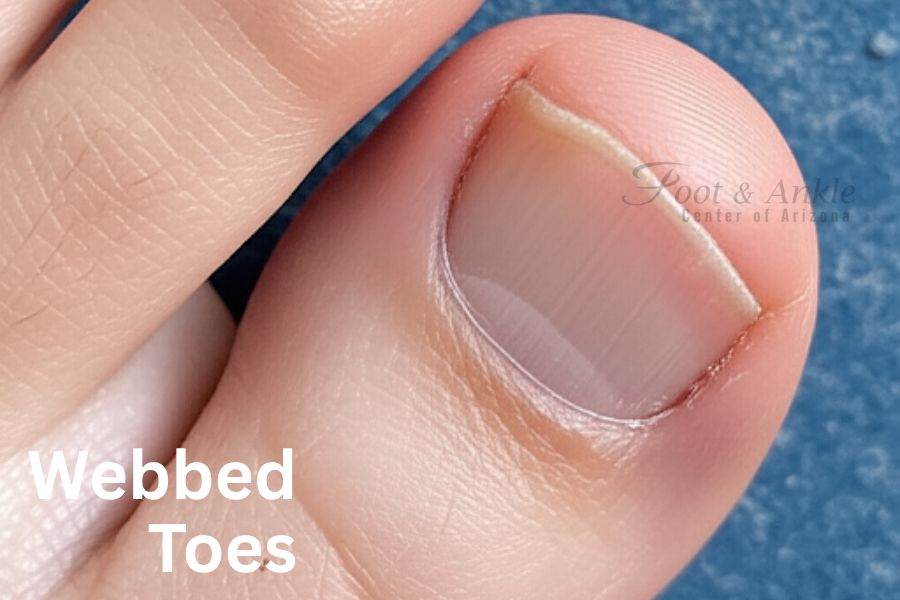What Is Webbed Toes in Humans?
Webbed toes in humans, also known as syndactyly, happen when two or more toes are joined together by skin, tissue, or bone. This condition is present at birth and is usually harmless. Many people think of it as unusual, but it is actually one of the most common foot differences found in babies.
What Do Webbed Toes Look Like?
Webbed toes can look different depending on how severe they are. In some people, only a small amount of skin connects the toes. In others, the toes may be fully joined from base to tip. The most common type is when the second and third toes are partially webbed.
What Are the Types of Webbed Toes?
Not all webbed toes are the same. They can be grouped into types based on how much of the toes are joined:
- Slightly webbed toes – Only a small piece of skin connects the toes.
- Minor webbed toes – The toes are connected halfway or more, but not completely.
- Complete webbing – Rarely, the toes are fused fully, including bones and joints.
Each type looks different, but most cases do not affect walking or daily activities.
Why Do People Have Webbed Toes?
You may wonder why webbed toes happen. During early pregnancy, all babies develop with webbed hands and feet. Normally, the tissue between the fingers and toes separates before birth. If this process does not fully finish, the toes may remain webbed.
Genetics can play a role, but in many cases, there is no clear reason. Webbed toes can also occur as part of certain syndromes, but most people with webbed toes are healthy and have no related conditions.
Is Webbed Toes a Sign of Inbreeding?
A common myth is that webbed toes are a sign of inbreeding. This is not true. Webbed toes happen naturally in the general population and are not linked to inbreeding. They are simply a variation in development that occurs in many families around the world.
How Many People Have Webbed Toes?
You may be surprised at how common this condition is. About 1 in every 2,000 to 2,500 babies is born with webbed toes or fingers. Most of the time, it affects the toes rather than the fingers. The condition is slightly more common in boys than girls.
Can Webbed Toes Cause Problems?
Most of the time, webbed toes do not cause medical problems. They do not affect walking, running, or balance. However, in some cases, webbed toes may:
- Make it harder to fit into certain shoes.
- Cause discomfort if the toes pull unevenly.
- Affect self-confidence because of appearance.
In rare cases, when bones or joints are fused, mobility may be limited. This is when doctors may suggest treatment.
How Are Webbed Toes Treated?
Treatment is usually not necessary unless the webbing causes problems. If a person wants treatment, the most common option is surgery.
- Surgical separation can be done when a child is young.
- Doctors carefully separate the toes and may use skin grafts to cover the gaps.
- Recovery takes time, and the results are usually good.
Adults can also have surgery, but recovery may be longer. Some people choose not to treat their webbed toes at all, especially if there are no problems with movement.
How Do People Live with Webbed Toes?
Living with webbed toes is not usually difficult. For most people, it is only a cosmetic difference. Some even view it as a unique trait that makes them special. In fact, several celebrities and athletes are known to have webbed toes.
If webbed toes affect confidence, surgery is an option, but many people live happily without treatment. Wearing comfortable shoes and focusing on foot health is often all that is needed.
Conclusion
Webbed toes in humans are a natural and fairly common condition. They happen when the toes do not fully separate during development. While they may look different, they rarely cause problems.
To recap:
- What is webbed toes? A condition where toes are joined.
- Why do people have webbed toes? It happens naturally during development.
- Is webbed toes a sign of inbreeding? No, it is not.
- How many people have webbed toes? Around 1 in 2,000 births.
- Can webbed toes cause problems? Usually not, but surgery can help if needed.
If you or someone you know has webbed toes, remember that it is nothing to worry about. It is simply a variation of human development that makes us all unique.




